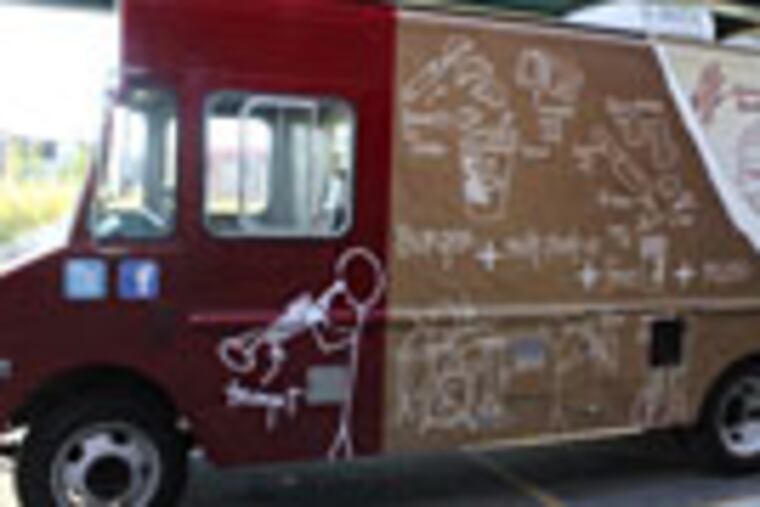Not all the appeal of a food truck is inside
The design came to her in a dream. Just as Keith Richards came up with the riff to "Satisfaction" in his sleep, Cupcake Lady Kate Carrara woke up one Sunday in 2009 and quickly grabbed crayons to record her vision of a cupcake truck. When she br

The design came to her in a dream. Just as Keith Richards came up with the riff to "Satisfaction" in his sleep, Cupcake Lady Kate Carrara woke up one Sunday in 2009 and quickly grabbed crayons to record her vision of a cupcake truck. When she brought the drawing of the white box truck sprinkled with giant jimmies and lined with a metal flounce to a car detailer, he said he could do everything except the giant cupcake springing from the roof. "Go under an overpass and you'll knock that thing right off," she remembers him saying. "He was right," she adds. "That cupcake would have been toast."
Aesthetic concerns about trucks' exteriors are a new development in the world of food trucks. For the most part, those launched before 2009 can't be found on Twitter. The owners of the old quilted stainless steel trucks are not concerned about a "wrap," the printed vinyl skin that envelopes some of the newer vehicles. The shift has been swift and dramatic. Like Carrara with her Buttercream Cupcake, many truck owners treat their vehicles like mobile ads.
The tipping point in the growing focus on food-truck design may have come in fall 2010 when architect Jennifer Siegal taught a course at the University of Southern California on solutions for "the deployable free-range cuisine truck culture." One of her students envisioned a vehicle with retractable legs that shoot up so the mobile cart could straddle and scoot over cars to deliver fresh doughnuts and coffee to captive commuters. That scheme is still more sci-fi than reality, but Jonathan Adams and Damien Pileggi upped the ante locally when they transformed an old DHL truck into Rival Bros., a deluxe coffee shop on wheels, this year and hired Red Tettemer to do the branding.
Creative director Todd Taylor listened to their influences - westerns, Americana, and rock-and-roll - and came back with the name Rival Bros., and a vintage image of two boxers with coffee mugs in place of gloves. The team kept the truck's design simple to set it apart from its visually busy colleagues, and considered details that influence the user experience. Customers are greeted with a menu framed in reclaimed wood and speakers playing rock-and-roll or blues.
"The truck is a moving outdoor piece," Taylor says, "but it's also a vending experience. The window is the place where they meet the public."
Addressing these multiple levels of interaction is key. "You want to strike a balance so it doesn't look like much from far away, but so it is something you want to lean into and look at when you get close," says Sara Selepouchin, owner and designer at Girls Can Tell.
Matt Feldman of Lucky Old Souls, a burger truck launched this fall, admired the diagram-inspired illustrations Selepouchin puts on towels and bibs at her East Passyunk shop and asked her to design some for his truck.
"Conceptually, the diagrams were a perfect fit," Selepouchin says, "because Matt is so exacting about his ingredients and his menu." She included a notation of his precise fry circumference, three-eighths of an inch, in her rendering of his fries.
Branding and designing a truck will never make up for inconsistent food, but James Moustafellos, associate director for the Center for Design and Innovation at Temple's Fox School of Business, has found that it helps.
When he sends master's of business administration and executive education students out to qualitatively assess North Philly's trucks, they continually point to the Sexy Green Truck as a positive example.
"They've created the strongest package," he says. "Everyone notices it because of the name, the branding - and the truck is bright green so you can't miss it." That truck's success, he says, lies in its acknowledgment of what makes it different.
An unintentional result of all these sexy trucks is to transform the perception of the old guard's lack of branding from dull to charming. The aesthetic chasm also handily illustrates food trucks' level playing field.
Iron Chef Jose Garces' truck, Guapos Tacos, is designed by Jun Aizaki, who also designed Tinto and Amada. Yet Tacos Don Memo, in a plain, quilted metal cart, gets equal or better ratings from foodies.
Still, Hilary Jay, executive director of DesignPhiladelphia, believes the decorated trucks make for a more successful city.
"In my mind they go together with the trash cans and the recycling trucks that were wrapped," she says. "People are happier when they see appealing street furniture, design in motion, and things that are visually fun."
Speaking of fun, Carrara is already dreaming of the next iteration of Buttercream Cupcake. She wants to project the cupcake logo into the sky, a la Batman. It would be like a retro version of Twitter. "I've got big dreams for the old girl," she says. "We'll see."